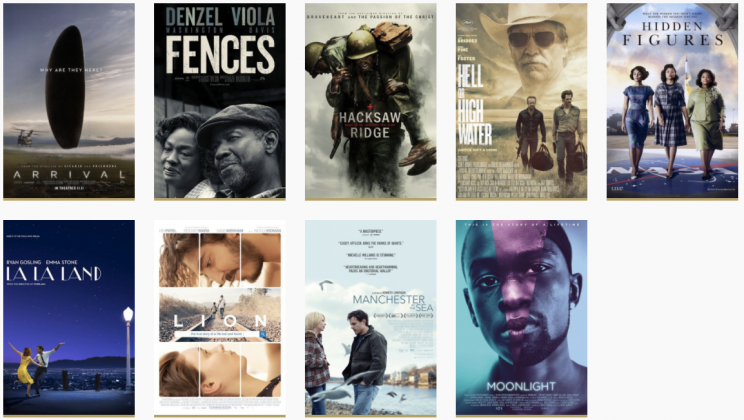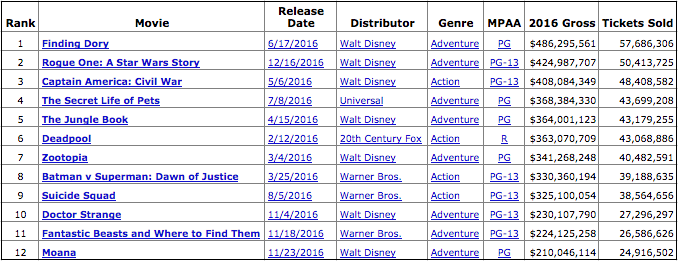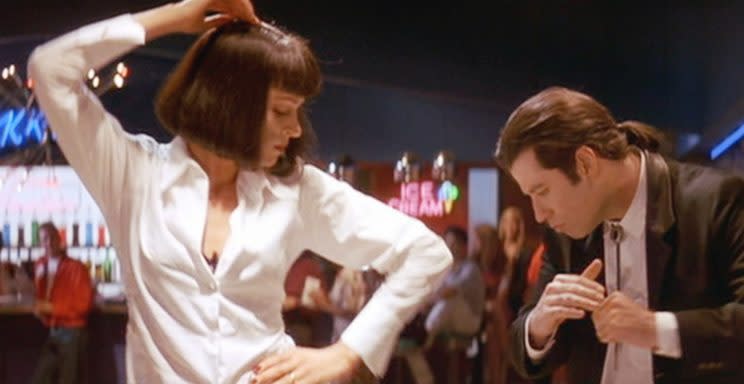There are two movie businesses, and both are losing to TV
The business of Hollywood has split.

The best way to illustrate this is to look at two very different groups of movies from last year. First let’s check out the nine movies nominated for best picture this year (above). A few things jump out at you.
Some of these movies are cool, like “Hell or High Water.” Some of them are moving, like “Moonlight” and “Hacksaw Ridge.” And some of them are pure confection, like “La La Land.” But they’re all pretty impressive in their own way. Let’s call this group the quality movies.
Next let’s look at the highest grossing movies of last year.

Here you have the likes of “Captain America,” “Star Wars,” “Finding Dory” and “The Secret Life of Pets,” all of which made over $350 million dollars. These are the movies that pay the bills in Hollywood, big action pictures and kids movies that play well globally where translations and subtitles don’t matter much because you can just watch the action. Let’s call them the money movies.
Now here’s what’s really interesting. These two groups of movies don’t overlap at all. Meaning none of the big money movies garnered best picture nominations, while none of the best picture nominees or quality movies made that much money. Crazy, right?
The top grossing picture nominated for a best picture Oscar? Try “Arrival,” at, get this, No. 31, nestled between an undistinguished remake, “The Magnificent Seven” and a lame-o sequel “Ride Along 2.” “La La Land,” by the way, checks in at No. 83.

What do these two Hollywoods have in common?
One thing that both the quality movies and the money movies do have in common is that none of them, and I mean none of them, are really culturally significant. What do I mean by that? I mean movies that resonate so strongly that people quote from them and kids dress up like their characters for Halloween. Think about “The Godfather,” “ET,” “Pulp Fiction” and well, “Star Wars”, when it first came out. Even a movie like “Jerry Maguire” for instance, generated a number of taglines—“You had me at hello,” Show me the money!” (Quick: Give me a line from “The Revenant” or “Sausage Party.”)
As recently as a decade or so ago, big blockbusters were also best picture candidates—and cultural events. I’m talking about movies like “Harry Potter,” “Lord of the Rings,” and “Toy Story.” Today? Well, let’s just say you didn’t see too many kids dressed up in “Suicide Squad” costumes last October.
Filmmakers now apparently have to choose: make money or make art. Either way, and even worse, it seems like not many of them are cracking our cultural code these days.
Where creative people are touching a cultural nerve, however, is on TV, and by TV I mean TV writ large, i.e. broadcast, cable and streaming. There are a number of reasons for this, but I think the biggest is the underlying business models of the movie studios versus the companies in the TV business.

Bottom line: The movie studios, now owned by the likes of Viacom, Time Warner, Comcast, 21st Century Fox, Sony and Disney are trying to protect huge global franchises with massive fixed costs, while TV—particularly streaming companies like Netflix, Amazon and HBO as well—are trying to push out the boundaries, scale their businesses and attract new audiences. And because they are willing to experiment and take risks—from “The Sopranos” to “Orange is the New Black”— in a way that even the quality films of Hollywood aren’t, the TV business is the one making the cultural impact.
People here at my job like to talk about “Game of Thrones,” “Billions,” “The Wire,” “Stranger Things,” and “Crashing.” But I don’t hear any conversations about either the money movies like “Deadpool” and the new Jason Bourne installment, or the quality movies like “Lion” and “Fences.”
I know you might be saying that I’m an urban elitist, and maybe that’s true. But I am certain that cutting edge TV shows are driving our culture in way that the movie business isn’t.
There’s no question that Hollywood could prove me wrong and once again make big high-quality movies that are successful—and culturally significant, (and yes that’s a tall order), but they didn’t do it in 2016.
Andy Serwer is Editor-in-Chief of Yahoo Finance.
Read more:

 Yahoo Finance
Yahoo Finance 
